These Islands Off Canada’s Atlantic Coast Are Actually Part of France — Here’s How to Plan Your Trip
Saint-Pierre and Miquelon are the last remaining French territories in North America, and they're closer than you think.
I first learned about the only piece of France in North America the old-fashioned way: scouring a world map. Looking at Newfoundland, I observed a topographical finger that seemed to point straight at two small dots tucked neatly off the coast of Canada. These dots are Saint-Pierre and Miquelon, a French territorial archipelago roughly 15 miles off Newfoundland. As I would find out, low-tech is the right approach to these islands; schedules are merely suggestions, and traffic lights don’t exist.
Time itself seems like an afterthought here. The islands are on their own time zone, half an hour ahead of the mainland. Depending on where you stand, your phone may vacillate between a Canadian carrier and a French one, changing the clock with each bounce off a cell tower. This is only a problem at lunch and dinner, when everything shuts down except for restaurants, which open strictly from 12 p.m. to 2 p.m., then again after 7 p.m. (Make reservations.)
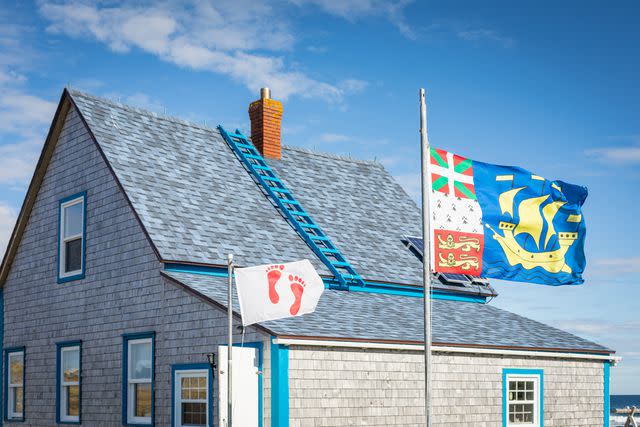
Mathieu Dupuis/Legendary Coasts CVB
Flags flying in front of a house on Miquelon.It’s all unmistakably France, but in a completely different landscape of rocky cape coastlines, peat bogs, wild orchids, and dune grasses. French is the prevailing language, of course, but you’ll occasionally find people who also speak English — more so in Saint-Pierre, the islands’ commercial center where roughly 5,000 people live within its 10 square miles. Neighboring Miquelon is only home to about 600 residents (and in summer, plenty of free-roaming horses and vacationers).
To really understand these islands, I started at the Musee de L’Arche, a shiny three-floor museum in Saint-Pierre that details centuries of history. The highlights: fishermen arrived from the Basque, Norman, and Breton regions of France sometime between 1520 and 1536, eventually creating permanent settlements in 1604. The British and French volleyed for possession of the islands for nearly a century until France gained control in 1763. Then, the islands became a refuge for Acadian deportees.
"Time itself seems like an afterthought here. The islands are on their own time zone, half an hour ahead of the mainland. Depending on where you stand, your phone may vacillate between a Canadian carrier and a French one, changing the clock with each bounce off a cell tower."
Cod fishing continued to attract more settlers in the 19th century, only to be stopped in the early 20th century once fish populations were decimated. Saint-Pierre found itself uniquely positioned as a French-governed outpost during Prohibition when alcohol storage and sales — especially to smugglers — made many islanders wealthy. (Al Capone was both a regular visitor and customer.) The museum’s collection of washed-up vintage crates and bottles paled in comparison to the relic downstairs: the only guillotine to have been used in North America, for an execution in Saint-Pierre in 1889.
After a stroll down the street to the wharf, I joined an enthusiastic guide, Eric Simon, on Le Petit Gravier, a quick 15-minute ferry that runs back and forth to to L'Île-aux-Marins (Sailors' Island). A stack of wheelbarrows right off the dock underscored the fact that there are no roads or cars on this island, which was last inhabited in the 1960s. Today, abandoned settlements are mixed in with restored summer homes. We walked the pathways mowed out of knee-high grass and wildflowers while Simon took me on an hour-long journey through the island’s history.
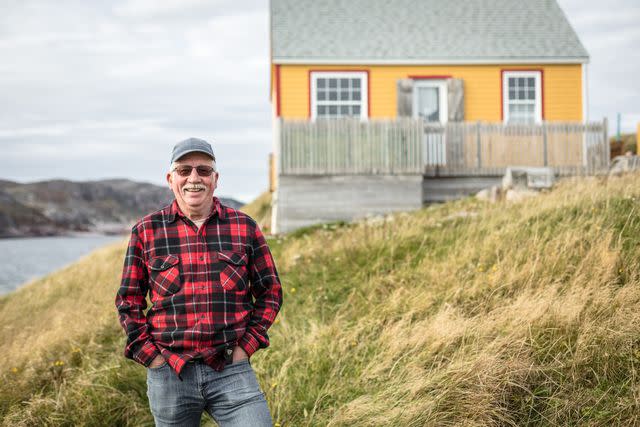
Mathieu Dupuis/Legendary Coasts CVB
A resident of Miquelon.Without a guide giving it context, the island would look like little more than a wild coastal ghost town. We passed large patches of rocks, once used for drying fish. Sounds of a folk music rehearsal drifted out of the church, down past a shrine and through the island’s seaside graveyard. Simon identified the oldest grave, a tipped and rusted iron cross with no markings, from 1876. We parted ways outside the Archipélitude Museum so I could peruse at my leisure. The museum is in the former island schoolhouse, now filled with every kind of antique and artifact related to L'Île-aux-Marins’ past. Outside, I followed the path to a quiet, rocky beach before returning to the ferry.
Breakfast the next morning at the family-owned Auberge Saint-Pierre was an assortment of pastries served in the inn’s kitchen. After a pain au chocolat, I headed back to the wharf to get the ferry to Miquelon. On the 90-minute journey, fog rolled across the coastline. There are three main roads on Miquelon, which is much quieter than its smaller neighbor. Even smaller is Langlade, home to free-grazing horses and seal colonies out on the Grand Barachois (best seen from a zodiac). Langlade used to be its own island, but now it’s connected by a sand isthmus.
More Trip Ideas: A Nova Scotia Road Trip
I met Francois Hoccry from Maison de la Nature et de l’Environnement (the island’s interpretive nature museum) for one of Miquelon’s premier activities: hiking. We set out for the Chemin des Boeufs, debating which way the fog would go. We were almost on the same latitude as Paris, but the landscape looked completely different. Because of the cold water Labrador Current in the north Atlantic Ocean, I was looking at the only place in France with boreal forests. Hoccry showed me four species of carnivorous plants, plus wild irises, orchids, daisies, buttercups, pitcher plants, and wildflowers. At a lookout, we watched birds and enjoyed Labrador tea made from leaves along the hike.
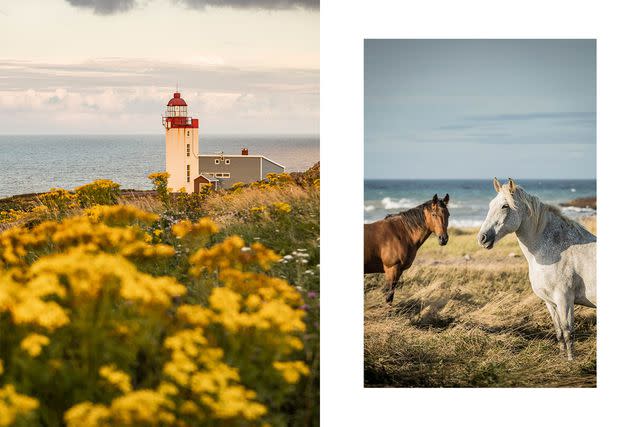
Mathieu Dupuis/Legendary Coasts CVB
After an outdoor lunch at the Mayou’naise (with a locally brewed Miqu’Ale), I strolled past the brightly colored houses to the center of town. Miquelon’s small village center is full of landmarks that tell the story of how people ended up here, by choice or by chance. Saint Pierre is the patron saint of fishermen in Catholicism, so it’s only fitting that Our Lady of Ardilliers church has a large wooden boat inside, dedicated to the community’s seafaring history. A monument outside details “the great Acadian upheaval,” where French Acadians were deported from Canada under British rule. The Miquelon museum across the street showcases household antiques, shipwreck artifacts, and other unique glimpses into island life over the years.
In the afternoon, I headed to Langlade to marvel at the large swaths of empty beaches and vacation houses surrounded by overgrown fields. If Saint-Pierre is the metropolis, Miquelon is the suburbs, and Langlade is the rural wilderness. On the other side of the island are camper vans with no electricity or amenities, popular with Saint-Pierre residents looking to reconnect with nature. I passed herds of horses along the isthmus on my way back to my room at Au P’tit Kakawi, a five-room bed-and-breakfast named after a long-tailed duck found on the island.
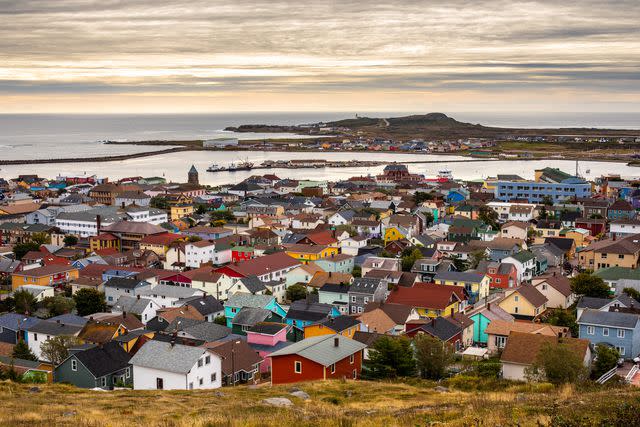
Mathieu Dupuis/Legendary Coasts CVB
Back on Saint-Pierre, I joined the morning line for the new Boulangerie des Graves next to the equally new hotel Las Terasses du Port. I enjoyed an éclair and coffee while sitting by the water. I looked across the cove at the colorful houses and boats that make up Saint-Pierre. Later, in the same spot at low tide, it was hard to tell whether each dark mass in the harbor was a rock or a seal — until it shimmied and stretched. I walked 15 minutes around the cove back into the center of town, passing nondescript construction warehouses that used to store barrels of alcohol during Prohibition.
Most businesses are closed on Sundays, unless there’s a cruise ship visiting, so on Sunday I wandered into the trinquet and watched men practice the Basque game of pilota. Before a friendly game, a kind stranger invited me onto the court and showed me how to throw and catch the rigid ball without injuring my hand.
"Saint-Pierre found itself uniquely positioned as a French-governed outpost during Prohibition when alcohol storage and sales — especially to smugglers — made many islanders wealthy. (Al Capone was both a regular visitor and customer.)"
I walked past the lighthouse, with L'Île-aux-Marins in the distance. Rows of small, brightly colored salines (colorful little saltbox huts that were used for drying fish) dot the coastline with boats pulled up outside directly onto the land. Saline 20 is home to Les Zigotos, a group of volunteers dedicated to preserving the culture and history of the dory, Saint-Pierre’s traditional wooden boat. At the end of the 19th century, there were more than 500 of these handmade vessels. Pierre Hélène and his father Gérard Hélène, two Zigotos, took me through their maritime museum and into a dory workshop, which used to be a Prohibition warehouse. On the way back, we stopped by the soccer field to drop Hélène son’s backpack, which he forgot earlier.
The true appeal of Saint-Pierre and Miquelon lies in its joie de vivre. This isn’t a place where you plan every hour of your day. At times, Saint-Pierre and Miquelon feel familiar. At other times, they feel completely foreign. But these islands seem happy to be in their own world, living life on their own time.
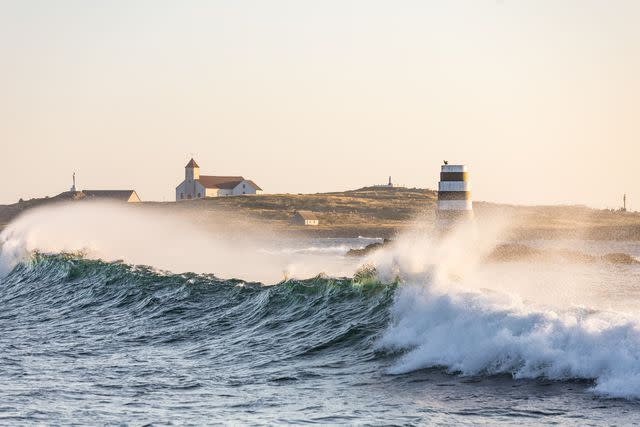
Mathieu Dupuis/Legendary Coasts CVB
A wave crashes along the coast of Miquelon near a lighthouse.How to Get There
Flights are available from Halifax, Nova Scotia (1.5 hours), Montreal (3 hours), and St. John's, Newfoundland (45 minutes) to Saint-Pierre.
Ferries (which allow cars) operate between Saint-Pierre and Fortune (south of Newfoundland), and between Miquelon and Fortune.
For more Travel & Leisure news, make sure to sign up for our newsletter!
Read the original article on Travel & Leisure.

